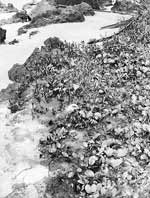| Monitoring
essential
By Marisa de Silva
According to environmentalists and
the Coast Conservation Department, the long term implications
of the oil spill, could be quite detrimental to the
environment and must be monitored closely.
 |
| Oil amidst the mangrove |
“The marine life that frequent
the surface of the ocean such as, turtles, dolphins,
sea birds and certain types of fish will be those worst
affected ,” said Prasanna Weerakkody, a Marine
Biologist, from the Nature Conservation Group, based
in Rumassala. However he said as it wasn’t a major
spill and as the vessel wasn’t an oil tanker,
its immediate repercussions have not yet adversely affected
the marine life or the reef adding that the full implications
of the spill were yet to be ascertained.
Although the beach and vegetation
clean up is being carried out, the problem area are
the rocks where the oil has got clogged up in the crevices
. He said the rock crabs in the area, especially were
showing obvious signs of stress even though they were
still alive.
Even the ‘Rock Hoppers’
(Bleenie), a type of fish largely found around rocky
areas, seemed to be behaving a bit unusually, he said.
However, there doesn’t seem
to be any significant impact on the mortality rate of
the marine life. Also, of the few fish that have died,
it’s only fish belonging to one particular family
of fish that have been affected he said.
He said the chemicals that got mixed
with the water as a result of the spill could have damaging
effects on the metabolism and reproductive functions
of all the vertebrates and the eco system, in the long
run. As for toxicity related issues (e.g. clogged gills
etc…) he warned that many of the affected fish
may even die in the weeks to come. Furthermore, it still
remains a mystery why there have been no fish (dead
or alive) in the rock pools in the area, after the spill,
he said.
Although it’s not a proven fact,
going by previous experiences, there has been a general
tendency for a rapid growth of algae on the reef. If
this were to happen then it could affect the coral and
other marine life in the months to come-- “especially
as the coral reefs are already under a lot of stress
ever since the 1998 bleaching incident,” he said.
As for the coastal vegetation which
generally stabilises the sand, the affected areas are
being cut out and cleaned alongside the beach clean
up operation.
However, in certain mangroves in the
area, there is up to four inches of oil deposited and
the areas will have to be monitored closely for effects
of pollution he warned.
“This was not a major spill
but it could serve as an eye opener as to whether we
are equipped to handle a major spill. Our capacity to
act fast to remedy the situation may still be lacking.
For instance, it’s essential to monitor the oil
slick formation and its course of direction right from
the time the vessel sinks, rather than wait for the
slick to hit the shore,” explained Mr. Weerakkody.
“Although there are authorities such as the Marine
Pollution Prevention Authority (MPPA), the Disaster
Management Centre (DMC), the National Aquatic Resources
Research and Development Agency (NARA) and the Coast
Conservation Department (CCD) that rise to the occasion,
we are yet not up to the mark, to face of such a crisis,”
he emphasised.
Acting Director of the Coast Conservation
Department - K.D.D. Wijewardena says that the beach
has now been cleaned up to a great extent and the Koggala
lagoon clean-up too is underway.
“The rock clean up however,
is the most difficult operation as it requires either
scraping off or high pressure spraying,” he added.
|
